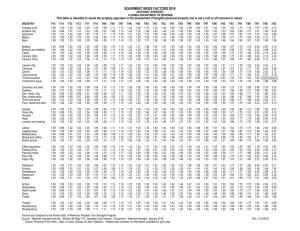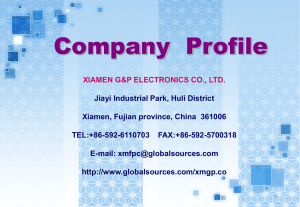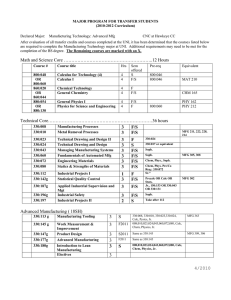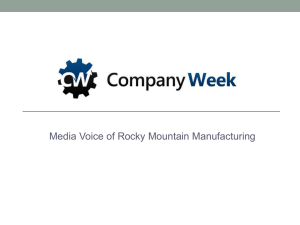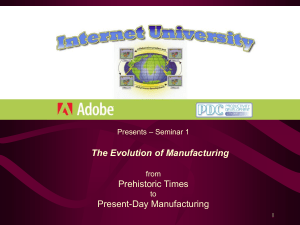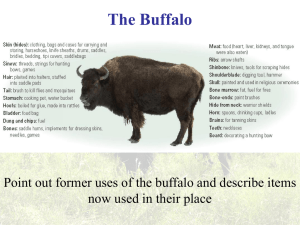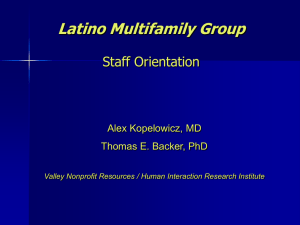Chapter 7 Manufacturing
advertisement
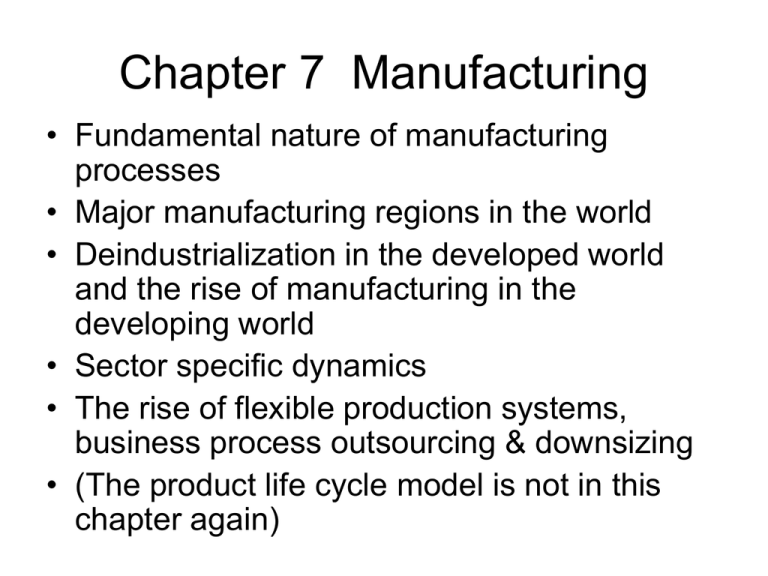
Chapter 7 Manufacturing • Fundamental nature of manufacturing processes • Major manufacturing regions in the world • Deindustrialization in the developed world and the rise of manufacturing in the developing world • Sector specific dynamics • The rise of flexible production systems, business process outsourcing & downsizing • (The product life cycle model is not in this chapter again) The Nature of Manufacturing • Elements of the manufacturing process: (a) product design, (b) assembling inputs, (c) transforming the inputs, (d) marketing the product • Location decision – Weber model again • Value added in each stage of production Porter’s Value Chain Firm Infrastructure Human Resource Management Technology Development Support Activities Procurement Primary Activities Inbound Logistics Outbound Marketing Logistics and Sales Operations Upstream value activities Service Downstream value activities Concentration of World Manufacturing 80% of Global Output in Three Regions How current are these data? Current role of China? Global Distribution Manufacturing Value Added Rest of World 8% North America 26% Other Asia 8% U.S. – 22.4% China 11% Japan 14% Europe 33% Source: Calculated from NationMaster.com Shares of Manufacturing Value Added Source: World Bank World Development Indicators, 2011 Rise of Maquiladoras – Border & interior Mexico U.S. & Canadian Manufacturing Belt: Accounts For about Two-thirds of Total Manufacturing Employment in The U.S. and Canada A good Overview Of specialized Versus market Oriented manufacturing Specialization in the Regional Distribution of Manufacturing • Some cartograms – where area is proportional to employment (using the BEA Economic Area classifications) • The first map shows the actual geometry of the BEA Economic Areas • The following maps depict industries distributed broadly across the U.S., and industries that are highly concentrated • These are old maps, but for many lines of manufacturing the data are probably relevant BEA Economic Areas – As of 1985 Other Manufacturing Regions • Europe – Figure 7.5, Japan - Figure 7.9 • Globalization of manufacturing – movement of capacity from U.S. & Canada, Europe, and Japan to less developed countries • “The new international division of labor” • “Anatomies of Job Loss” U.S. Manufacturing Employment Trend 2012 2013 xx Change in U.S. Mfg. Employment 1960-2000 Post-2000 Trends? Deindustrialization in industrialized countries The Share of Mfg. may have fallen, but real mfg. output is probably up in all these countries – see next slide for WA state Real Output by Industry WA State $35,000 Natural Resources $30,000 Food Products Output ($1972 in millions) $25,000 Forest Products Aerospace $20,000 Other Manufacturing $15,000 Construction $10,000 Transport, Communications & Utilities Trade $5,000 FIRE Services $0 1967 1972 1982 1987 1997 2002 2007 Anatomies of Job-Loss: disinvestment Broad Corporate The “outfall” Spatial Structural Trends Agency of restructuring Macroscale causal forces in the global Corporate responses to global trends Corporate competitive Plant openings Plant closings economy strategies In-situ changes outcomes Events on the ground Bluestone & Harrison - Deindustrialization of America: “The core of B&H’s argument followed a restructuring approach with the need to restore the drive to accumulate, producing, through spatially distributed effects, a major reworking of the role of U.S. cities and regions in the geographic distribution of production.” Impacts on Manufacturing Jobs in U.S., Europe and Japan • Job losses in manufacturing in all of these regions • Replacement has primarily been in services • Occupations created in the services are frequently very different than occupations lost in manufacturing, leading to high unemployment rates and income deterioration Assets of Centers of Control versus Peripheral Regions Centers of Control Peripheral Regions • Key role in circulation; realizing wealth • Focal point for investment, profits, interest • Focus on forms of capital: FIRE • Occupational dominance by professionals • “Virtuous” multiplier relationships driven by above points • Support networks of a large cadre of service workers in lower occupational categories • Key role in creating value through labor pools & resource endowment • Compete with centers for capital • Capital transfers to core; possible scarcity in periphery No direct transference • Multipliers chancy: impacts only if investment comes to them • Employment fortunes conditioned by “waves of investment” and restructuring Current Spatial Outcomes in the U.S. • Old centers are having their power erode • New centers are rising, based on redistribution – Charlotte NC - banking or the rise of “new industrial spaces” - Orlando-Melbourne (retirement) - Las Vegas (entertainment) - Seattle & Atlanta - technology based manufacturing & information services • The rural renaissance - retirement, footloose entrepreneurs, recreation, rich people, niche mfg., IT, commuter air and courier services
